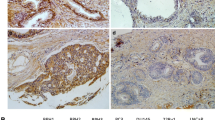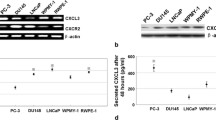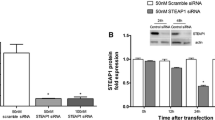Abstract
Purpose
A novel tumor suppressor gene CKLF-like MARVEL transmembrane domain-containing member 3 (CMTM3) is reduced or undetectable in many kinds of cancers and relates tumor malignant features. We detected its role in prostate cancer for possibility of target therapy as accumulating evidence has shown that CMTM3 is a promising tumor suppressor gene (TSG) for gene therapy.
Methods
The expression of CMTM3 detected in prostate tissue microarray, specimens and cell lines were evaluated by immunohistochemistry and semi-quantitative PCR and Western blot, respectively. After being transfected with CMTM3 adenovirus or vector (mock), the proliferation and migration and invasion of LNCaP cells were detected by transwell assay and matrigel assay, respectively. Furthermore, the effects of CMTM3 on tumor growth were performed in nude mice xenograft in vivo.
Results
We found CMTM3 was reduced in PCa tissues and cells compared with BPH tissues, and its expression in PCa tissues was related to the Gleason score. Moreover, after being transfected with adenovirus, ectopic expression of CMTM3 in LNCaP cells led to significant inhibition of cell proliferation and migration and invasion compared with the control (P < 0.05), which may be attributed to decreased Erk1/2 activity as p-Erk1/2 was remarkably reduced when CMTM3 was overexpressed. Finally, restoration of CMTM3 significantly suppressed xenograft tumor growth in vivo (P < 0.01).



Similar content being viewed by others
References
Siegel R, Naishadham D, Jemal A. Cancer statistics, 2012. CA Cancer J Clin. 2012;62(1):10–29.
Han W, Ding P, Xu M, Wang L, Rui M, Shi S, et al. Identification of eight genes encoding chemokine-like factor superfamily members 1–8 (CKLFSF1–8) by in silico cloning and experimental validation. Genomics. 2003;81(6):609–17.
Su Yu, Lin Yi, Zhang Lianhai, Liu Baocai, Yuan Wanqiong, Mo **aoning, et al. CMTM3 inhibits cell migration and invasion and correlates with favorable prognosis in gastric cancer. Cancer Sci. 2014;105(1):26–34.
Li Zesong, **, Sun **aojuan, et al. CMTM3 inhibits human testicular cancer cell growth through inducing cell-cycle arrest and apoptosis. PLoS One. 2014;9(2):e88965.
Wang Y, Li J, Cui Y, Li T, Ng KM, Geng H, et al. CMTM3, located at the critical tumor suppressor locus 16q22.1, is silenced by CpG methylation in carcinomas and inhibits tumor cell growth through inducing apoptosis. Cancer Res. 2009;69:5194–201.
**e J, Yuan Y, Liu Z, **ao Y, Zhang X, Qin C, et al. CMTM3 is frequently reduced in clear cell renal cell carcinoma and exhibits tumor suppressor activities. Clin Transl Oncol. 2013;16:402–9.
Di Meo S, Airoldi I, Sorrentino C, Zorzoli A, Esposito S, Di E, et al. Interleukin-30 expression in prostate cancer and its draining lymph nodes correlates with advanced grade and stage. Clin Cancer Res. 2014;20(3):585–94.
Sasaki T, Ryo A, Uemura H, Ishiguro H, Inayama Y, Yamanaka S, et al. An immunohistochemical scoring system of prolyl isomerase Pin1 for predicting relapse of prostate carcinoma after radical prostatectomy. Pathol Res Pract. 2006;202(5):357–64.
Shao L, Cui Y, Li H, Liu Y, Zhao H, Wang Y, et al. CMTM5 exhibits tumor suppressor activities and is frequently silenced by methylation in carcinoma cell lines. Clin Cancer Res. 2007;13(19):5756–62.
Wang Y, Li T, Qiu X, Mo X, Zhang Y, Song Q, et al. CMTM3 can affect the transcription activity of androgen receptor and inhibit the expression level of PSA in LNCaP cells. Biochem Biophys Res Commun. 2008;371:54–8.
Lessel D, Gamulin M, Kulis T, Toliat MR, Grgic M, Friedrich K, et al. Replication of genetic susceptibility loci for testicular germ cell cancer in the Croatian population. Carcinogenesis. 2012;33:1548–52.
Sanchez-Pulido L, Martin-Belmonte F, Valencia A, Alonso MA. MARVEL: a conserved domain involved in membrane apposition events. Trends Biochem Sci. 2002;27(12):599–601.
Livak KJ, Schmittgen TD. Analysis of relative gene expression data using real-time quantitative PCR and the 2(-Delta C (T)) method. Methods. 2001;25:402–8.
Y **ao, Y Yuan, Y Zhang, J Li,Z Liu, X Zhang et al. CMTM5 is reduced in prostate cancer and inhibits cancer cell growth in vitro and in vivo. Clin Transl Oncol. 2014 [Epub ahead of print].
Sasaki T, Ryo A, Uemura H, Ishiguro H, Inayama Y, Yamanaka S. Animmunohistochemical scoring system of prolyl isomerase Pin1 for predictingrelapse of prostate carcinoma after radical prostatectomy. Pathol Res Pract. 2006;202:357–64.
Chen Y, Zheng L, Liu J, Zhou Z, Cao X, Lv X, et al. Shikonin inhibits prostate cancer cells metastasis by reducing matrix metalloproteinase-2/-9 expression via AKT/mTOR and ROS/ERK1/2 pathways. Int Immunopharmacol. 2014;21(2):447–55.
Carvajal-Carmona LGl, Cazier JB, Jones AM, Howarth K, Broderick P, Pittman A. Fine-map** of colorectal cancer susceptibility loci at 8q23.3, 16q22.1 and 19q13.11: refinement of association signals and use of in silico analysis to suggest functional variation and unexpected candidate target genes. Hum Mol Genet. 2011;20:2879–88.
Friedl P, Wolf K. Tumour-cell invasion and migration: diversity and escape mechanisms. Nat Rev Cancer. 2003;3:362–74.
Wang Y, Li J, Cui Y, Li T, Ng KM, Geng H, et al. CMTM3, located at the critical tumor suppressor locus 16q22.1, is silenced by CpG methylation in carcinomas and inhibits tumor cell growth through inducing apoptosis. Cancer Res. 2009;69(12):5194–201.
Sridhar SC, Miranti CK. Tetraspanin KAI1/CD82 suppresses invasion by inhibiting integrin-dependent crosstalk with c-Met receptor and Src kinases. Oncogene. 2006;25(16):2367–78.
Sharma S, Kelly TK, Jones PA. Epigenetics in cancer. Carcinogenesis. 2010;31:27–36.
Acknowledgments
This work was supported by the National Natural Science Foundation of China (No. 31171341). We thank Professor Han and Peking University Center for Human Disease Genomics for their generous offer of CMTM3 antibody and adenovirus vector. We also thank the Peking University Department of Pathology for their technology support of immunohistochemistry and staining evaluation.
Conflict of interest
The authors declare no conflict of interest.
Author information
Authors and Affiliations
Corresponding authors
Rights and permissions
About this article
Cite this article
Hu, F., Yuan, W., Wang, X. et al. CMTM3 is reduced in prostate cancer and inhibits migration, invasion and growth of LNCaP cells. Clin Transl Oncol 17, 632–639 (2015). https://doi.org/10.1007/s12094-015-1288-9
Received:
Accepted:
Published:
Issue Date:
DOI: https://doi.org/10.1007/s12094-015-1288-9




